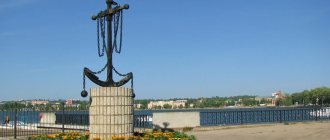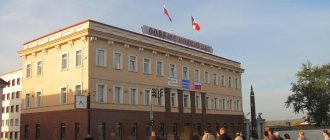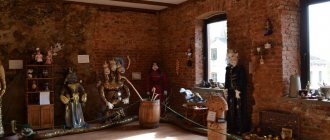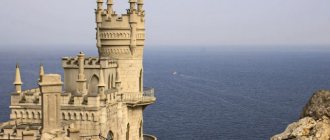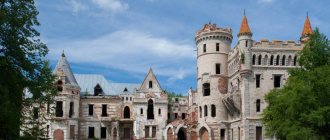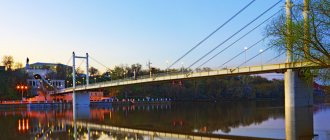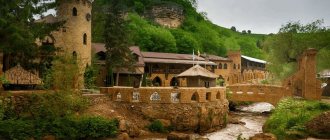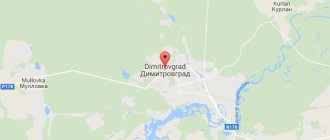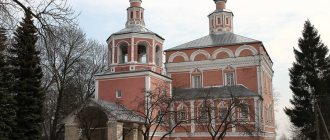A little about the city
The city of Belev is practically the same age as Moscow - the first mentions of it were preserved in chronicles dating back to 1147. In the 4th century it was under the rule of Lithuania and for some time was the center of an appanage principality. It was an important strategic point within the Russian state.
In the 18th century, Belev lost its military significance and turned into a quiet provincial town, which it remains to this day. Despite the small territory occupied by the city, there are many interesting and memorable places: churches, monasteries, museums. We present descriptions of the sights of Belev and photos in this review.
Belev gave the country great people
“Sloboda” continues the series of publications about the regional centers of the Tula region and talks about Belev, an ancient city with a rich history.
2008 View of Belev at the entrance from Tula.
PRIDE AND LEGENDS OF BELEV
- Pastila is the main pride. The recipe for pastila from Antonov apples belongs to the merchant Ambrosy Prokhorov. In 1881, he moved on to industrial production of the delicacy. Now you can buy marshmallows at the Belevsky market (200 rubles per “brick”).
- Belevsky lace. Their production first began in the 17th century. The entire female population of Belev was engaged in weaving lace with bobbins. Lace enjoyed success in fashion houses in Russia and Europe.
- Hydrogen sulfide source. 7 km from Belev towards the village of Bakino, a hydrogen sulfide spring flows to the left of the bridge. You can find it by the characteristic smell of rotten eggs. The local population has been coming for this healing water for a long time. They say that water flows from the same vein as Krainka.
- Underground passage from Belev to Zhabyn. An ancient legend says that it begins in the basement of a monastery, passes under the riverbed of the Oka and ends in Zhabyn. They say that only monks could pass through this tunnel, and strangers could not find a way out. To this day no one has been able to find the passage.
- In Belev last summer they filmed the film “Parental Toast” about the Second World War. Belev was not chosen by chance: many pre-war houses have been preserved here, which have become a natural setting.
- The wife of Emperor Alexander I, Elizaveta Alekseevna, died in Belev on May 4, 1826. During the trip, she became ill (cerebral aneurysm), and had to stop in Belevo. She died in the house of the Belevsky merchants Dorofeevs; the police are now located in this building. After the autopsy, Elizabeth’s internal organs were placed in a vessel, which was buried in Belev, and the coffin with the body was sent to the capital. In 1837, a monument was erected near the burial site.
OUR REFERENCE Belev, like Moscow, was first mentioned in the chronicle for 1147. In the 13th century, the city came under the rule of the Grand Duchy of Lithuania. From the late XIV - early XV centuries and until 1558 it was the center of the appanage Belevsky principality. Since the 16th century, the Belevskaya Fortress was part of the Zasechnaya Line on the southern outskirts of Russia.
40s of the XIX century. This is what the Holy Cross and Spaso-Preobrazhensky monasteries looked like.
2007 Still from the film “Parental Toast”. Starring: young actor Pasha Melenchuk and actor of the Tula Drama Theater Igor Nebolsin.
The monastery of Macarius Zhabynsky and the holy spring, located 7 km from Belev, are a place of pilgrimage for thousands of believers.
BY THE WAY, LEGENDARY NATIVES AND GUESTS OF BELEV
| Vasily Andreevich Zhukovsky , the great Russian poet, was born on January 29 (February 9), 1783 in the village of Mishenskoye, Belevsky district. Zhukovsky is considered the founder of romanticism in Russian poetry. |
| Mikhail Mikhailovich Prishvin (January 23 (February 4), 1873 - January 16, 1954), a famous writer, lived and worked in Belev from 1910 to 1912. |
| Alexander Sergeevich Pushkin passed through Belev during his trip to the Caucasus in May 1829. He dined at a restaurant located in a corner house on what is now Revolution Square. |
| Alexander Sergeevich Dargomyzhsky (1813-1869), a great composer, was born in the village of Dargomyzhka, Belevsky district. Author of the operas “Rusalka”, “The Stone Guest”, and many romances. |
| Emperor Alexander II , being heir to the throne, stayed in Belev while traveling around Russia in the summer of 1837. |
| Ivan the Terrible personally came to inspect the Belev Fortress, which was a border on the southern borders of the state. The Tsar also visited the Spaso-Preobrazhensky Monastery. |
TERRITORY AND POPULATION 1180 sq. km - area of Belevsky district, including: 114 sq. km - Belev area 174 settlements within the district, including: 1 city - Belev 2 rivers flow through the territory of the district - Oka and Vyrka (tributary of the Klyazma) 22.5 thousand people. live in Belevsky district, of which: 14.8 thousand people. live in Belev itself
EDUCATION AND CULTURE 34 educational institutions 29 large enterprises 3 monasteries and 12 churches 1 art museum 1 house of culture 1 art school More than 100 buildings are under state protection
Olga SMIRNOVA, photo by Sergei KIREEV.
Museum of Local Lore
We suggest you start getting acquainted with the city by visiting the Museum of Local Lore, which was founded in 1910 as a museum of educational and visual aids. The basis of the exhibition was made up of items that were purchased at the agricultural exhibition by the Zemstvo Duma of Belev. A series of portraits of Russian emperors and princes was presented by the artist P. V. Zhukovsky, the son of a famous poet. He also became the first trustee of the museum, where by that time works by Repin, Aivazovsky, Savrasov, and Shishkin were already exhibited.
After Zhukovsky's death (1912), the museum received his name. After the revolution, the collection was expanded and the museum was given the status of a local history museum. In 1941, the building in which the exhibition was located was destroyed by fire. Some exhibits were lost. Only in 1960 was it decided to reopen the Local History Museum in the city. Today it is one of the main attractions of the city of Belev in the Tula region.
The museum today occupies two floors in a 19th-century merchant mansion. Its main fund consists of more than 18 thousand exhibits, which is replenished every year with new finds. There are departments here that are dedicated to the history and nature of the city, as well as art.
Belev
In 1437, the future founder of the Kazan Khanate, Ulu-Mukhammed, stood with an army in Belev. This led to the Belevsky massacre.
In 1555, Ivan Sheremetyev began his campaign along the Muravsky Way from Belev (the first mention of this road). This campaign led to the Battle of Sudbischi. Battle of Judgment
From 1558 to 1561, the owner of the city of Belyov was Dmitry Vishnevetsky (Bayda).
In 1700, Chelyuskin was born in Belyov, Semyon Ivanovich - a Russian polar navigator.
On January 29 (February 9), 1783, the famous Russian poet Vasily Andreevich Zhukovsky was born in the village of Mishenskoye, Belevsky district.
On August 15, 1794, in the village of Salnitsa, Belevsky district, the famous Tula historian Ivan Fedorovich Afremov was born.
On February 11 (23), 1808, in the village of Dolbino near Belyov, P. V. Kireevsky was born - a famous folklorist, archaeographer, writer, creator of the first national folklore corpus.
In 1814, the Russian writer Tatyana Alekseevna Astrakova was born in Belyov.
In 1828, in Belyov, in a middle-class family, P. M. Martynov was born - a teacher, local historian, author of essays and articles on the history and culture of the Tula region.
Monument in Belyov at the burial site of internal organs removed from the body of Elizaveta Alekseevna during embalming
On May 4, 1826, in Belyov, while traveling from Taganrog, the Russian Empress Elizaveta Alekseevna, the wife of Emperor Alexander I, died. Now the district police department is located in the building where the Empress died[29].
On May 4, 1829, during a trip to the Caucasus, A.S. Pushkin passed through Belyov.
In 1833, Russian merchant and entrepreneur Ivan Ivanovich Ignatov was born here. On July 19-20, 1837, while traveling around Russia, the heir to the throne, Tsarevich Alexander Nikolaevich, the future Emperor Alexander II “the Liberator,” stopped in Belyov.
On November 7 (15), 1852, in the village of Belmovo, Belyovsky district, a participant in the Battle of Tsushima, Rear Admiral Manuil Vasilyevich Ozerov, was born.
In June 1865, Mikhail Fedorovich Burtsev, archpriest of the Resurrection Church, writer, local historian and public church figure, chose the path of the priest of the Resurrection Church of Belyov.
On November 8 (20), 1869, the poet and publicist of the Silver Age, Zinaida Gippius, the “decadent Madonna,” was born in Belyov [30].
In 1874, in Belyov, P. G. Ignatov, a geographer-researcher and leader of expeditions to study the lakes of Western Siberia, Kazakhstan and Altai, was born into a merchant family.
On April 16 (28), 1883, V. O. Kappel was born in Belyov, a Russian military leader, one of the leaders of the White movement in Siberia, Commander-in-Chief of the armies of the Eastern Front (1919).
In 1888 Treyvas, Aron Borisovich, Doctor of Technical Sciences, Professor, was born.
In 1899, N. A. Petrunichev, manager of the affairs of the Council of People's Commissars of the USSR in 1937-1938, was born in Belyov.
Sergei Petrovich Borodin, a famous Soviet writer, author of several historical novels, was born in Belyov in 1902 and lived until 1922.
On December 27, 1905, Oleg Viktorovich Tolstikov was born - a Soviet military pilot and military leader, a participant in the Great Patriotic War, commander of the 9th mixed, and subsequently the 10th assault aviation corps during the Great Patriotic War, colonel general of aviation.
1910-1912 - the Belevsky period of the life and work of the writer Mikhail Mikhailovich Prishvin.
On December 16, 1937, the famous sculptor, member of the presidium of the Russian Academy of Arts, Albert Serafimovich Charkin was born in Belyov.
On March 31, 1938, the Russian theologian, teacher and publicist, member of the Inter-Council Presence of the Russian Orthodox Church, Alexey Ilyich Osipov, was born in Belyov.
On March 14, 1953, a famous scientist, Doctor of Technical Sciences, Professor Alexander Viktorovich Fedukhin was born in Belev.
Spaso-Preobrazhensky Monastery
One of the most popular attractions in Beleva. The Spaso-Preobrazhensky Monastery is the only surviving religious building of the 16th century in the Tula region. It was founded by local princes in 1525. During its heyday it was a rich and large monastery. His possessions included the estates of appanage princes, which, by order of Tsar Ivan IV, were transferred to the monastery, as well as lands on the banks of the Oka River, more than a hundred kilometers long, with lakes and tributaries. The monastery owned thirteen villages with peasants and land.
In 1921, the monastery was closed by the new authorities. The domes and utensils were looted, some rooms were converted into residential areas. Today, the dilapidated monastery is being restored, although not very quickly.
The monastery has preserved the Vvedenskaya Church, the Transfiguration Cathedral, and the Church of Metropolitan Alexy. The necropolis contains the remains of honorary citizens. The relics of St. Nikephoros, who is especially revered by local residents, are preserved here.
What to see in Belyov
Like many provincial Russian towns, Belyov boasts a colorful history but modest modernity. Little has been preserved from the past in reality, and even in the memory of the residents. The place remains unchanged and authentic - the high bank above the spectacular bend of the Oka, marked by monastery churches on the old site.
The historical center of the city is two almost merged monasteries, Spaso-Preobrazhensky and Krestovozdvizhensky. Recently dilapidated, they are slowly being restored. Formally, the Holy Cross Monastery no longer exists - in 2010 it was decided to join the neighboring Spassky Monastery. But this is only on paper, and on the banks of the Oka everything remains the same. For almost three hundred years, two cathedrals, two bell towers and two monasteries have stood side by side, separated by a low wall and an orchard. The Holy Cross has always been feminine, and the Savior of Transfiguration has always been masculine. Now they seem to have finally grown together, but each has its own, separate story. Also in the Belevsky district on the Oka River there is the Holy Vvedensky Makarievsky Zhabynsky Belevsky Monastery (Pustyn).
Among the city brands, apple marshmallow stands out, no less legendary than Tula gingerbread. Three Russian cities were famous for pastila: Kolomna, Rzhev and just Belev. Once upon a time, it was made in almost every Belevsky house that had a garden, from Antonovka carrion: the pulp of baked apples was beaten together with sugar and egg whites, then rolled into a roll. The right marshmallow is made handicraft, at home, and also in the village of Bogdanovo near Belev, at the Belevskie Sladosti enterprise. It’s really worth a try, if only because the vast majority of people have no idea what Russian pastila should really be like. There is also the opportunity to visit the factory founded by A. Prokhorov. Tourists dress in white clothes and enter the “workshop” for making sweets. They witness the production of marshmallows at every stage: from loading raw materials to baking sweet layers. At the end there will be a master class for those interested (to be agreed upon upon request).
However, Belev has historically been a place that everyone passes through. Empress Elizaveta Alekseevna, the widow of Alexander I, even died here while passing through from Taganrog, which became the most important event in local history for the entire 19th century. In addition, through Belev, Pushkin proceeded to the Caucasus (this is marked by a romantic-looking bust installed in front of a very shabby Soviet-built house), and Gogol and Leo Tolstoy to Optina Pustyn. Lev Nikolaevich passed through Belyov more than once: having set off on his last journey from Yasnaya Polyana, he dined at the buffet at the Belyovsky station. The station is still the same, a commemorative plaque hangs on it, but the lunch can only be repeated symbolically - everything inside was completely rebuilt after the war.
Turgenev also wandered around Belyovsky with a gun, but no stray hare ran away from him towards the town, so there was no reason to erect a monument. Zinaida Gippius, born in Belyov, is also not noted.
Zhukovsky is considered the main Belevsky writer and historical character. Near Belev was his favorite estate, Mishenskoye, where Vasily Andreevich spent his childhood and then wrote many poems. The poet’s drawings depict beautiful local and city landscapes - subtle, transparent and romantic. The city museum of local history is named after Zhukovsky’s son, Pavel Vasilyevich, an academician artist who founded the first city museum at the beginning of the 20th century.
Belev is one of the most promising cities in the Tula region in terms of tourism development. It is located on the banks of the Oka River in one of the most picturesque and ecologically clean places in the region, and the potential of the territory’s tourist resources allows the development of such types of tourism as military-patriotic, cultural, educational, religious, gastronomic, industrial, as well as hunting and fishing.
Church of the Nativity
One of the most famous sights of Belev in the Tula region is the ancient Orthodox Church of the Nativity of the Blessed Virgin Mary. It was founded at the beginning of the 18th century. The temple building was one of the first stone structures built after the severe fire of 1719.
Over its long history, it was reconstructed several times, but the work was partial and local in nature. Vivid examples of later buildings include the bell tower, built in 1876 in the pseudo-Russian style. During another reconstruction of the temple (early 19th century), two limits appeared. They are consecrated in honor of Sergius of Radonezh and Nicholas the Wonderworker.
The cathedral was closed in 1930, but was reopened quite quickly - in 1943. From that moment on, he never stopped his activities. It is still in effect today. Nowadays, this famous landmark of Belev has received the status of the cathedral of the Tula diocese. This is one of the most revered Orthodox churches in the region. Experts consider the condition of the building to be ideal. The church regularly holds services, and the parish is famous in the region for its missionary and charitable activities.
Makarievskaya Zhabynskaya hermitage
Along with the famous “places of power” of Tibet, Stonehenge and others, there are several places in Russia whose energy is no less strong. In ancient times, pagan temples were located in such places, and later monasteries were built. There is such a landmark in Belevo.
On the lands of the monastery of Makariy Zhabynsky there is the Makarievsky Cathedral, in which the relics of this saint are carefully preserved. Not far from the temple there is a holy spring with a bathhouse. Near the source you can see an ancient oak tree, the branches of which are hung with ribbons left by visitors.
Like many attractions of Belev, the source has a beautiful legend. During the Time of Troubles, when the Polish-Lithuanian invaders moved to Rus', Macarius lived on this land. One day the ascetic met a Pole from the army of Pan Lisovsky in the forest. He was dying of wounds and thirst.
Macarius took pity on the enemy and struck the ground next to him with his staff. Immediately at this place a life-giving spring began to flow. The warrior quenched his thirst, washed his wounds and began to recover. As legend has it, he later even converted to Orthodoxy.
Several inexplicable events that occurred after the 1917 revolution are associated with this landmark of Belev. Believers consider them to be God's providence. In the thirties of the last century, when the monastery was converted into a school, a door had to be cut in one of its walls. The workers categorically refused to do this work, since Jesus Christ was depicted on the wall, and the door had to be cut at the level of the Lord’s knees.
However, there was a brave soul who completed the task. Three months later, a slab at another construction site collapsed on the atheist, breaking his legs at the knees. In the 60s of the 20th century, the authorities of Belev decided to open the tomb of St. Macarius. The reason for such a strange decision is unknown. A huge pit was dug, more than five meters deep, but the builders did not find any relics under the shrine. The monks are sure that the Lord moved the remains of the saint to prevent desecration.
